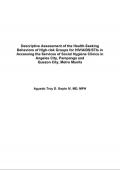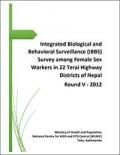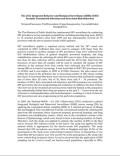What's New
Displaying results 3511 - 3520 of 4914

Resource | Publications,
In the Asia region, an increasing number of HIV infections occur among men who have sex with men (MSM) and transgender people. Unless effective HIV prevention strategies are implemented, the Commission on AIDS in Asia's regional projections predict that about half (46%) of all new HIV infections in Asia will soon be among MSM, an increase of 13% from 2008. While inadequate HIV data exists on transgender women due to their limited inclusion in national HIV surveillance systems, studies that do exist show transgender women are at disproportionate risk for HIV infection.
Young MSM and transgender people in Asia Pacific are at high risk for HIV. Like their older peers who are MSM and/or transgender, these young people face additional barriers to services due to the criminalization of male-to-male sex in 19 out of 38 countries in the Asia-Pacific region, and the intense stigma experienced from family, employers, service-providers and the state (among others).

Resource | Publications,
Hijras and other transgender (TG) people in India face a variety of issues. So far, Hijra/TG communities have been excluded from effectively participating in social and cultural life; economy; and politics and decision-making processes. A primary reason (and consequence) of the exclusion is the lack of (or ambiguity in) legal recognition of the gender status of hijras and other transgender people. It is a key barrier that often prevents them in exercising their civil rights in their desired gender. So far, there is no single comprehensive source on the basis of which an evidence-based advocacy action plan can be prepared by transgender activists or possible legal solutions can be arrived at by policymakers. This background document, hopefully will lead to further consultations with trans communities and other stakeholders, could be an essential first step towards achieving the legal rights of hijras/transgender people in India.
The overall purpose of the assignment was to build an evidence-base for improving universal access to HIV prevention services, rights and social protection services for hijras/transgender people.

Resource | Guidelines,
The purpose of this document is to provide guidance to national AIDS programmes and partners actively involved in the country response to AIDS on use of core indicators to measure and report on the national response.

Resource | Publications,
In recent years, there has been a dramatic increase in new cases of HIV/AIDS as reported by the Department of Health (DOH). As of the latest HIV/AIDS Surveillance Report from the Philippine HIV and AIDS Registry of the National Epidemiology Center of the DOH, the surge in the number of cases of HIV for the month of November 2011 alone is 89% higher compared to the same period from the previous year. In the same report, from January to November 2011, 96% of 2081 newly diagnosed cases were infected through sexual contact with a majority of male cases (1,859 males and 133 females infected through sexual transmission).
Resource | Presentations,
Browse and view tables, charts and graphs illustrating data on HIV prevalence and epidemiology, risk behaviors, vulnerability and HIV knowledge, HIV expenditures, and national responses in the Pacific Island Countries and Territories (PICT).

Resource | Publications,
This is the fifth round of the Integrated Biological and Behavioral Surveillance Survey (IBBS) conducted among Female Sex Workers (FSWs) of 22 Terai Highway Districts. This was a cross-sectional survey in which a total of 610 Female Sex Workers (FSWs) were recruited; out of the total respondents, 400 were recruited from 16 districts domain, and remaining 210 were recruited from 16 districts domain.

Resource | Publications,
This fourth round of IBBS survey recruited 400 men who have sex with men (MSM) and transgender people (TG) in Kathmandu Valley (Kathmandu, Lalitpur, and Bhaktapur). The respondent-driven sampling (RDS) methodology was adopted to recruit the possible survey participants. This survey was carried out primarily to determine) among MSM in the Kathmandu Valley and to assess their HIV/STI-related risk behaviors, including their sexual practices. The survey also aimed to measure their exposure to the intervention programs targeted at MSM/TG in the valley. At the same time, it has sought to analyze trends through the comparison of data on selected variables obtained from first, second, third and fourth rounds of the IBBS.

Resource | Publications,
The fifth round of IBBS among 360 male People Who Inject Drugs (PWID) in three Eastern Terai districts (Jhapa, Morang, and Sunsari) was conducted by the NCASC with financial support from the Global Fund. This survey primarily collected strategic information needed to analyze the trends in risk behaviors associated with HIV/STI infection among PWID.

Resource | Publications,
The Bureau of Epidemiology has conducted HIV surveillance among direct and indirect sex workers since 1989 to monitor and control the HIV epidemic. This has empowered sex workers and enabled them to negotiate for safer sex and condom use, leading to proactive service delivery and consistent access to STI services.

Resource | Publications,
HIV surveillance applies a repeated survey method, and the 28th round was conducted in 2010. Collected data were used to compare with those from the previous rounds to monitor changes of HIV prevalence. Data were collected from IDU rehabilitation clinics of general hospitals, provincial hospitals, and drug rehabilitation centers by collecting all visited IDU cases in June. If the sample size is less than 10, data collection will be extended until the 15th of July. Data from the provinces of more than 20 samples will be used to calculate the median of HIV infection at the national level.





